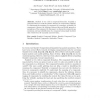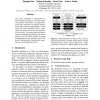ACL
2009
13 years 9 months ago
2009
We investigate the task of unsupervised constituency parsing from bilingual parallel corpora. Our goal is to use bilingual cues to learn improved parsing models for each language ...
ACL
2009
13 years 9 months ago
2009
Statistical machine translation (SMT) models require bilingual corpora for training, and these corpora are often multilingual with parallel text in multiple languages simultaneous...
ACL
2009
13 years 9 months ago
2009
This paper presents an unsupervised opinion analysis method for debate-side classification, i.e., recognizing which stance a person is taking in an online debate. In order to hand...
ACL
2009
13 years 9 months ago
2009
We present a new approach to learning a semantic parser (a system that maps natural language sentences into logical form). Unlike previous methods, it exploits an existing syntact...
SANSKRIT
2010
13 years 9 months ago
2010
Sanskrit is very rich in compound formation. Typically a compound does not code the relation between its components explicitly. To understand the meaning of a compound, it is neces...
NAACL
2010
13 years 9 months ago
2010
We examine the viability of building large polarity lexicons semi-automatically from the web. We begin by describing a graph propagation framework inspired by previous work on con...
NAACL
2010
13 years 9 months ago
2010
In this paper, we present an innovative chart mining technique for improving parse coverage based on partial parse outputs from precision grammars. The general approach of mining ...
NAACL
2010
13 years 9 months ago
2010
Two of the mechanisms for creating natural transitions between adjacent sentences in a text, resulting in local coherence, involve discourse relations and switches of focus of att...
NAACL
2010
13 years 9 months ago
2010
This paper contributes a formalization of frame-semantic parsing as a structure prediction problem and describes an implemented parser that transforms an English sentence into a f...
NAACL
2010
13 years 9 months ago
2010
We address the problem of formatting the output of an automatic speech recognition (ASR) system for readability, while preserving wordlevel timing information of the transcript. O...


